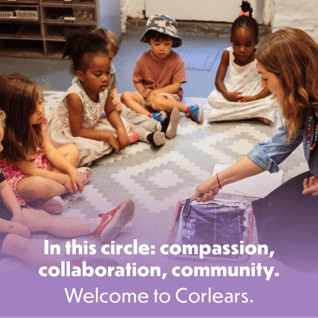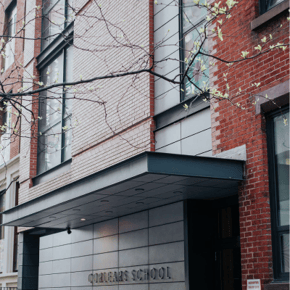Students enrolled in the nursery program at Corlears School experience a temporarily modified schedule at the beginning of the year designed to ease them into their school experience. The process, known as “phase-in,” is one of the ways Corlears supports 1- and 2-year-olds in separating from their primary caregivers and building attachments to their new teachers.
Attending a school program for the first time means learning many new skills, including one of the biggest and most foundational: separating from parents and caregivers and building new, trusting relationships with teachers who will provide comfort, ease, security and affection at school.
As a small school community, centered on the developmental needs of young children, Corlears values the importance of a gradual separation and attachment process beginning at the start of the school year.
With our 1- and 2-year-old students in the toddler and nursery programs, this includes the implementation of a supportive and responsive “phase-in schedule,” which is about 1–3 weeks of shorter school days and gradually extending them.
This gradual transition supports children in intimate ways as they adjust to the absence of their parent/caregiver and form meaningful relationships in the presence of their teachers and peers, while also building stamina for the longer school day.
Phase-In Schedules and the 'Transfer of Trust'
Separations happen throughout the course of our lives and involve numerous feelings and emotional responses. The separation-attachment process is a foundational experience that will inform all future journeys of separation-attachment in life, while also reinforcing the theoretical concept of object permanence in action ("you go away... and ...you always come back”). That which goes away (parent/caregiver), still exists in the heart and mind of your child.
In the youngest of classrooms, we support the social-emotional and relational framework defined as the "transfer of trust." This "transfer of trust" from parent/caregiver to teacher is initially, and then continually, experienced during the phase-in period as the teacher is able to meet the needs of the child in healthy and responsive ways. Concurrently, the parent/caregiver experiences consistency and continuity of the process by saying goodbye to the child, trusting that the teacher will meet the needs of their child, and returning at the end of the school day as a celebratory reunion.
Examples of Corlears School's Phase-In Schedule
The phase-in approach is tailored to each cohort's unique characteristics, such as program duration, age range, and group size.
The youngest Seedlings can take 4–6 weeks to phase in. In their few days of school, younger Seedlings may spend just one hour in the classroom with a smaller group of their classmates; as their other classmates complete phase-in at alternating times. Time spent at school is gradually lengthened over three weeks, and class sizes are gradually increased
Older children in their second year of program follow a similar schedule, but their phase-in could take 1–3 weeks.
By their final week of phase-in, students have developed school stamina, taken part in the all-important transfer of trust through the separation-attachment process, and they are ready to spend their entire school day with all of their classmates — and future friends! — in the same classroom.
Students enrolled in the half-day program dismiss before noon; for full-day students, classroom teachers will work with parents and the Early Childhood Division Director to determine whether the child is ready for their extended days to begin.
The phase-in schedule could be expedited at any time that the teachers feel the class can either come together sooner or extend the day longer. That said, every child is different, and the separation-attachment process is designed for Corlears teachers to work with and meet each child and family’s needs along the way.
For more detail, see this schedule from a previous school year as an example of what you can expect. Note that schedules are subject to change year over year, depending on a classroom's developmental readiness and other factors.
What to Expect During Phase-In
In the days leading up to the start of school, our early childhood teachers will ask caregivers for photos of the children to display in the classroom, have caregivers complete an “All About Me” book of family photos to bring comfort during the day, and invite families to school for a warm-up day.
In addition, caregivers are encouraged to follow these steps to facilitate a successful phase-in:
- Prepare your child for school. Ahead of the fall, begin talking about school and what it will mean to go to school. Check out these ideas for activities and books to read together.
- Allow children to bring a transitional object from home. This may be a stuffie or a favorite toy. The object may change from day to day, but this object is a reminder of home and is always easily accessible and within reach, especially when or if parents are not. Read more about the importance of transitional objects in this Dimensions of Early Childhood article written by Colleen Goddard, Ph.D., Corlears School’s Early Childhood Division Director.
- Always say goodbye, and follow through. Caregivers should say goodbye once, tell the child truthfully what they’re doing and where they're going. Then, follow through with the goodbye, even if the child cries or says not to leave. When you return, greet your child so they know you always come back. Both the goodbye and the return/reunion establishes trust. We recommend watching our video on how to say goodbye.
- Expect tears. Be prepared and understand that children may cry during this process. Even with a mindful phase-in schedule in place, attending school is a brand new experience for children at this young age and will come with bumps in the road. Rest assured: separation anxiety is completely normal for children at this age and will get better with time.
- Stay close. During the phase-in, families/caregivers should expect to remain in close proximity to the school for the first 15 minutes after arrival. In rare circumstances, the family/caregiver will be contacted to return to the school for an early pick up when a child is having a difficult time making the transition.
- Be patient. The transfer of trust takes time, and each child adjusts to the change in their own time.
At Corlears, we view early childhood education as a collaborative journey with families, guided by our own knowledge, expertise, and observation of each child's uniqueness. Our approach to separation-attachment is an intentional and thoughtful process meant to build trust for the whole family each step of the way.



